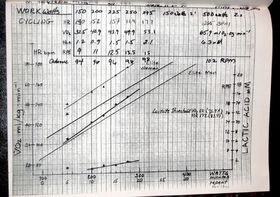 So, you’re relatively new to the sport of triathlon. You’ve met other triathletes, perhaps become involved in a triathlon group or club, and you search out triathlon information on the Internet.
So, you’re relatively new to the sport of triathlon. You’ve met other triathletes, perhaps become involved in a triathlon group or club, and you search out triathlon information on the Internet.
You have more or less figured out the main pieces involved in triathlon training and competition, but there are a few things that are still a little foggy. Like VO2 max. You’ve heard the term, but it’s all Greek to you.
Let me help. Here’s everything you want to know about measuring and testing VO2 max…
What Is VO2 Max?
VO2 max is the maximum capacity of an individual’s body to transport and utilize oxygen during maximal physical exertion.
The name is derived from:
- V – volume per time
- O2 – oxygen
- Max – maximum
Other terms that are synonymous with VO2 max are “maximal oxygen consumption,” “maximal oxygen uptake” or “aerobic capacity.”
A person’s VO2 max reflects their level of physical fitness.
Why Is VO2 Max Important?
VO2 max is considered the best indicator of cardiorespiratory fitness or endurance.
Cardiorespiratory fitness refers to the ability of the circulatory and respiratory systems to supply oxygen to muscles during sustained physical activity. Regular exercise makes these systems more efficient in 4 key ways:
-
enlarging the heart muscle
-
enabling more blood to be pumped with each stroke
-
increasing the number of small arteries in trained muscles, which supply more blood to working muscles
-
increasing the amount of oxygen that is inhaled and distributed to body tissues
Simply put, your VO2 max tells you how big of an “engine” you have in your “car.”
What’s Your VO2 Max?
Determining VO2 max is specific to the mode of training used by an athlete.
For example, runners are generally tested on a treadmill, and cyclists are tested on a cycle ergometer. Because triathletes engage in 3 aerobic modes of exercise, each using different muscle groups, they are usually tested with 3 different trial types to monitor their training program.
Your absolute VO2 is the volume of oxygen your body can take in and process. This is expressed in liters. A better value for comparison of triathletes is in milliliters, per kilogram, per minute (ml/kg/min). This is the volume of oxygen the body uses per kilogram of body weight during one minute of exercise at a maximal level.
Things That Affect Your VO2 Max
There are various factors that affect your max VO2. One of the most significant factors is training.
A deconditioned individual or newbie triathlete will see the biggest increase in VO2 max in their first season, while a seasoned triathlete may have to work much harder to see any improvement.
Unfortunately, another significant factor that determines your VO2 max is genetic. Like a lot of performance characteristics, you can thank (or blame) your parents for your aerobic capacity. It is roughly 20-30% trainable.
Max VO2 does degrade with age and usually starts to drop off after the age of 40, perhaps a bit later for women. Conditioned athletes usually range from 40 to 60 ml/kg/min. An athlete over 70 would be considered very exceptional. Lance Armstrong is said to have been tested in the high 80’s.
High vs Low VO2 Max
So, a triathlete with a large VO2 number always wins, right? Not necessarily.
Although VO2 max is a major indicator of fitness and endurance level, it’s certainly not the only one.
Other relevant indicators of a triathlete’s performance include:
-
muscular strength and power;
-
endurance;
-
economy or efficiency of movement (technique);
-
sustainable power or speed at lactate threshold;
-
and anaerobic repeatability.
Take economy (technique) for instance. A runner that has very efficient form may be able to surpass an athlete with a higher VO2 max simply because they do not use as much energy. This is especially true in the water where swim technique is critical.
And don’t forget the significance of body weight. You may have a very high VO2 max. But if you gain weight, your relative number decreases. This, of course, works in the opposite direction as well. Dropping body fat has a direct affect on your relative VO2 and power to weight ratio.
Measuring Your VO2 Max
 Sports technology, like any other, eventually trickles down to the masses. Amateur triathletes now have access to some of the same testing and evaluation processes that the pros do. However, this testing can sometimes seem complicated and confusing to the triathlete.
Sports technology, like any other, eventually trickles down to the masses. Amateur triathletes now have access to some of the same testing and evaluation processes that the pros do. However, this testing can sometimes seem complicated and confusing to the triathlete.
Ideally, VO2 max testing is administered by a coach or a professional who not only understands the science, but can explain how to apply it to an athlete’s training. It will cost $125 – $200 for a professional VO2 max test.
There are also do-it-yourself tools for estimating your VO2 max.
Should You Get Tested?
A VO2 test usually tells you a lot more than just your max VO2. Aerobic and anaerobic thresholds, calories burned at various intensities, and energy system development are also quantified. These numbers can be applied directly to your training.
The test can also establish accurate heart rate training zones. The test usually entails breathing into a tube or mask while doing a graded exercise protocol. For the triathlete, VO2 max testing would involve testi
ng for both running and cycling.
Once completed, the test administrator should sit down with you, explain your results, and answer your questions. They should also explain how to improve your VO2 max. Although it may only be partially trainable, a small improvement can yield big results.
If you are just starting in the sport of triathlon, a VO2 test is a great way to establish your fitness baseline. You don’t need to get retested frequently; maybe one or two times per season. It is also important to note that even if your max VO2 does not improve much, the watts or speed you are putting out at max VO2 can improve, perhaps dramatically. Focus more on improvement of performance versus your number.
In case you’re wondering, there really isn’t a VO2 max test for swimming. Instead, common tests used for benchmarks include:
Critical Swim Speed (CSS): Swim a hard 400 meters and then after a swim down, swim a hard 50 meters. The simple equation will work out your critical swim speed. As your aerobic capacity improves your CSS will increase.
Timed Swims: Periodically swim as far as you can in 20 or 30 minutes. From comparing results you can see if technique and fitness are improving through a simple increase in distance swum. By taking your average speed, pace times can be calculated for regular swim sets.
Stroke/Time Scores: Add a 25 meter stroke count to a time taken for swimming 25 meters. If more speed comes from a higher stroke count then your overall score does not decrease. If you attempt to reduce your overall score by taking fewer strokes then time may well go up. You need to hit an optimum stroke count, not a minimum.
Step Tests: Perform a 7×200 meter step test. Heart Rate (HR), stroke count, split times should all be checked and noted. The first 200 meters is swum at 60 beats per minute (BPM) below max HR and you descend the set so that the last 200 meters is swum at max HR. From the results, you can record max HR, best time for the 200, swim velocity (average for 100 meters in seconds), stroke rate (strokes per minute) and stroke count (strokes per 25m/50m). Having a helper on poolside would be of great use.



